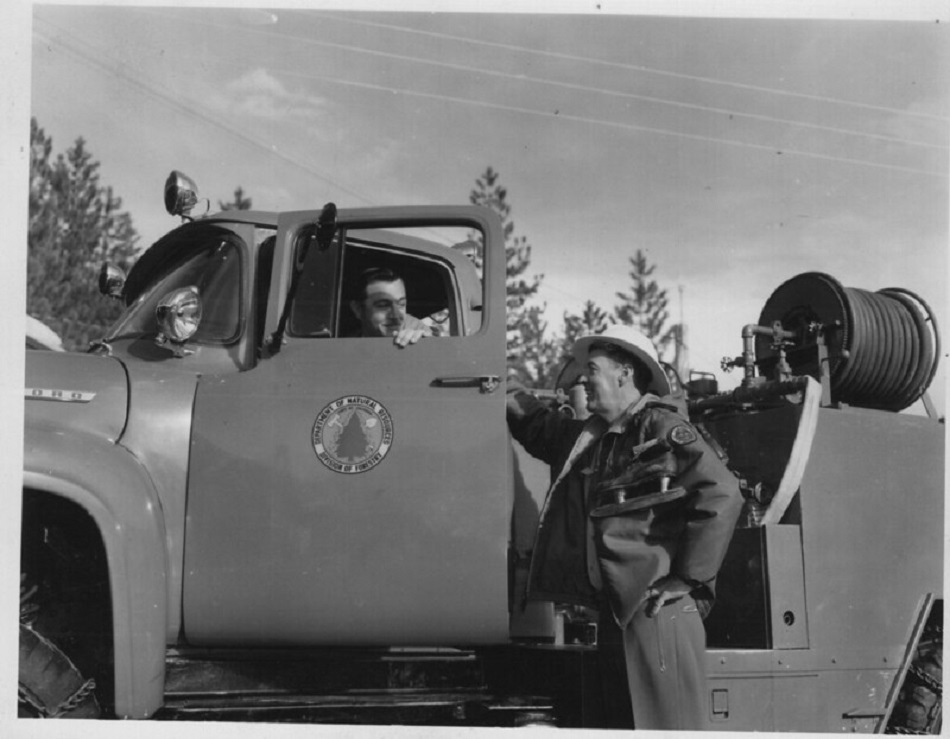Our Organization
Learn more about CAL FIRE’s history and our organization.
Preventing wildfires in the State Responsibility Area (SRA) is a vital part of CAL FIRE’s mission. While these efforts have occurred since the early days of the Department, CAL FIRE has adapted to the evolving destructive wildfires and succeeded in significantly increasing its efforts in fire prevention. The Department's Fire Prevention Program consists of multiple activities including wildland pre-fire engineering, vegetation management, fire planning, education and law enforcement. Typical fire prevention projects include brush clearance, prescribed fire, defensible space inspections, emergency evacuation planning, fire prevention education, fire hazard severity mapping, and fire-related law enforcement activities.
Beyond its wildland firefighting role, CAL FIRE is an "all-risk” department. It may very well be a CAL FIRE engine and crew that is dispatched to the scene of an auto accident, or to a home where a child has become the victim of a drowning incident. The Department is always ready to respond - medical aids; hazardous material spills; swift water rescues; search and rescue missions; civil disturbances; train wrecks; floods, earthquakes and more.
In light of the Department's extensive size and wealth of experience in managing major incidents, it is routinely called upon to provide invaluable assistance and assume leadership roles during times of disaster. Notably, the Department has been instrumental in a multitude of significant incidents, unequivocally demonstrating its expertise and unwavering commitment to public safety. These include its pivotal roles in responding to the Northern and Central California floods of 1997, 1998, and 2006, during which its swift and highly effective response not only saved innumerable lives but also substantially mitigated widespread damage.
In 1991, during the Cantara train derailment and hazardous spill, the Department's specialized teams played an indispensable role in containing and successfully resolving the perilous situation. Similarly, the catastrophic Northridge earthquake of 1994 and the Loma Prieta earthquake of 1989 spurred the Department into rapid, well-coordinated action, delivering much-needed relief to the affected communities.
The Department's extensive experience also encompasses the adept handling of the 1991 Tunnel Fire in the Oakland/Berkeley Hills, the Southern California fire sieges of 2003, 2017, 2019, and most recently, the 2020 fire siege, where over 600 wildfires were ignited across Northern California due to a massive summer thunderstorm that generated thousands of dry lightning strikes. Beyond these events, the Department's steadfast commitment to public safety is further underscored by its involvement in numerous other significant incidents, including the 2002 Exotic Newcastle Disease outbreak, the 2009 H1N1 Swine Flu Pandemic, the 2015 Refugio Oil Spill, the 2017 Oroville Dam Break, the COVID-19 pandemic, and the 2023 Extreme Winter events that blanketed the Sierra Nevada and Southern California mountain ranges with record-setting snow, causing breaches in levees and flooding communities.
As part of the CAL FIRE team since 1995, the Office of the State Fire Marshal (OSFM) supports the CAL FIRE mission to protect life and property through fire prevention engineering programs, law and code enforcement and education. The OSFM provides for fire prevention by enforcing fire-related laws in state-owned or operated buildings, investigating arson fires in California, licensing those who inspect and service fire protection systems, approving fireworks as safe and sane for use in California, regulating the use of chemical flame retardants, evaluating building materials against fire safety standards, regulating hazardous liquid pipelines, and tracking incident statistics for local and state government emergency response agencies.
The OSFM, State Fire Training, and CAL FIRE Academy programs provide training education and certification programs for the California Fire Service. Through practical training exercises and classroom courses, every California firefighter is exposed to training standards that have been approved by CAL FIRE and OSFM, each among the best institutions in the nation for fire training education.
CAL FIRE’s mission emphasizes the management and protection of California’s natural resources; a goal that is accomplished through ongoing assessment and study of the State's natural resources and an extensive CAL FIRE Resource Management Program. CAL FIRE oversees enforcement of California’s forest practice regulations, which guide timber harvesting on private lands. Reviews and inspections ensure protection of watershed and wildlife, as well as renewal of timber resources. Department foresters and fire personnel work closely to encourage and implement fuels management projects to reduce the threat of uncontrolled wildfires. CAL FIRE Foresters promote conservation and the importance of our trees and forests to Californians of all ages.
CAL FIRE manages 14 Demonstration State Forests that provide for commercial timber production, public recreation, and research and demonstration of good forest management practices. Additional forestry programs include urban forestry, archaeology, pest management, etc.
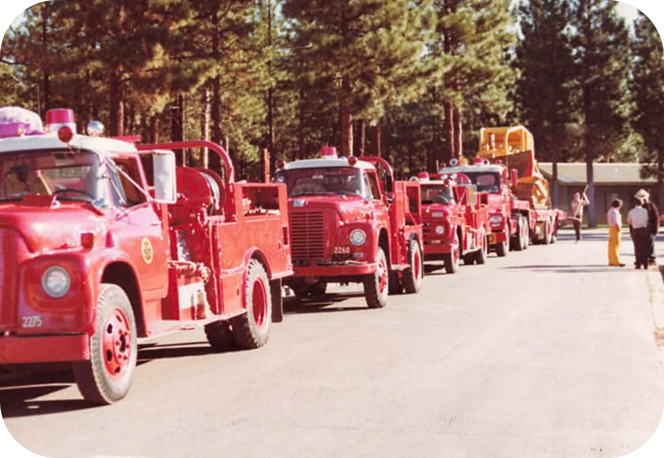
CAL FIRE is a State agency responsible for protecting natural resources from fire on land designated by the State Board of Forestry as State Responsibility Area (SRA). CAL FIRE also manages the State Forest system and has responsibility to enforce the forest practice regulations, which govern forestry practices on private and other non-federal lands. Two major themes are attendant to the CAL FIRE mission. One is the protection of the State's merchantable timber on all non-federal lands from improper logging activities and the other is the protection of the State's grass, brush, and tree covered watersheds in SRA from wildland fire. CAL FIRE is a "conservation agency" with origins stemming from the "Conservation Movement" of the last century.
In the latter half of the 19th century, Americans collectively voiced concern about the health and long term availability of the Nation's timber supply. They were alarmed by newspaper accounts of a succession of conflagration fires that had burned millions of acres in the upper mid-West and by the continuing reports of massive timber destruction by homestead and lumber industry land clearing practices. The prevalent idea that at least one-fifth of a given land area should be covered in trees to sustain a successful agricultural industry added weight to the anxiety and led to deliberations on how to control western development of the public domain (Federal land). A widely circulated belief that America might face a timber "famine" or shortage gave momentum to the dialogue. Many also believed that trees caused it to rain and by removing them the Nation ran the risk of converting its western territories, if not the whole country, into a vast desert. Also, the prevailing attitude that the forests of America were infinite, and infinitely forgiving of mankind's exploits, was beginning to wane especially now that the American frontier had reached the western shore.
The 19th century was a period of rapid western expansion for America and the general rule was to transfer the public domain (Federal land) into private ownership. But a growing number of Americans wanted to see the Federal Government withdraw certain tracts of the public domain from private settlement and manage the areas in trust for present and future generations. Two parallel movements emerged to address the disposition of the public domain. One was the drive to "preserve" the Nation's natural wonders from privatization. The other was to "conserve" the Nation's storehouse of lumber trees. The first could be said to have started in 1864 when the United States Government gifted the Yosemite Grant and Mariposa Grove to the State of California. In 1866, the California State Legislature accepted this land grant with the understanding that the areas were to be managed for the benefit of present and future generations. Although it was a State park, these two grants signaled the beginning of a federal park program. The advent of a true national park system came with the creation of Yellowstone National Park in 1872 in Wyoming, some 18 years before Yosemite itself became a national park.
The United States Army was assigned the responsibility to patrol and protect this area. The Army's role included the detection and suppression of wildfire within park boundaries. This was no small task considering the size of the sanctuary, the crude equipment at hand, and the few troops that were assigned. Even though the U.S. Cavalry was a far cry from the wildland fire profession of today, they nonetheless represented the beginning of a Federal wildland fire protection program. One noteworthy Army idea was the creation of "campgrounds." These were set up as a means to contain the continuing nuisance of abandoned campfires. In 1890, the Sequoia and General Grant Parks, and the Yosemite Forest Preserve were created. The U.S. Army's qualified success in Yellowstone led to the implementation of Cavalry patrols within these parks in 1891.
As for forestry management, simple laws to protect certain types of trees had been around since colonial times. The creation of the Department of Agriculture in 1862 marks the beginnings of a national effort to protect the nation's agricultural health. It wasn't until 1875, though, that Congress allocated $2,000 to the Department for the purpose of hiring a forestry agent to investigate the subject of timber management. This was unanticipated, since the discipline of forestry was new and there were very few trained foresters in America at this time. In 1881, a Division of Forestry was created and in 1889, the Department of Agriculture was raised to Cabinet level status. Meanwhile, all Federal land remained under the control of the Department of Interior, specifically the General Land Office (GLO).
Bernhard Fernow, Division of Forestry Chief from 1886 to 1898, endorsed the creation of forest reserves and pointed out the need to transfer control of these lands from the General Land Office to the Department of Agriculture. This would insure that government foresters would have the leverage needed to enforce proper timber management practices. Fernow even drafted an organizational scheme that included the idea that "rangers" would be in charge of the smallest administrative units. Stiff opposition against creating federal reserves was overcome in 1891 when Congress passed the Forest Reserve Act. The President was given the authorization to permanently withdraw from the public domain, forestlands he deemed of national importance. The Act did not, however, specify what constituted "forest" land. The people of Southern California capitalized on this by successfully lobbying for the creation of the San Gabriel Forest Reserve, a largely brush covered region whose value lies in its being an important watershed for the Los Angeles Basin. Southern Californians had long been witness to the devastation that wildland fire could bring. They had seen how hillsides denuded by fall fires became a catalyst for flooding and mudslides when winter rains hit. This, in turn, wreaked havoc on the agricultural lands in the Basin below. The Sundry Civil Appropriations Act (Organic Act) of 1897 clarified the intent of the Forest Reserve Act and specifically endorsed the validity of watershed protection. In fact, timber and watershed protection were the cornerstones upon which existing reserves were expanded and future reserves established.
As for Fernow's efforts to wrestle control of the Forest Reserves from the Department of Interior, this fell to his successor, Gifford Pinchot. Pinchot is viewed as the "father" of the Forest Service. He served as Chief Forester from 1898 to 1910. His close friendship with President Theodore Roosevelt undoubtedly played a key role in the latter's executive order, of early 1905, which transferred the growing collection of Forest Reserves from the Interior Department to the Department of Agriculture. Had he been so inclined, Pinchot probably could have gained control of the federal parklands. But Pinchot was a forester intent on instituting wise management upon timber-producing lands for commercial use. He was not out to cultivate trees for recreational enjoyment (utilitarian conservation as opposed to aesthetic preservation). Within a few weeks of Roosevelt's order, Pinchot reorganized the Agriculture Department's Bureau of Forestry into the United States Forest Service. In 1907, the Forest Reserves were renamed National Forests.
The U.S. Forest Service became the Nation's primary instrument, for protecting natural resources on Federal land from fire and from timber exploitation. In the teens the National Park Service was established, and charged with protecting the Nation's scenic wonders. Both agencies, however, were protecting only those areas of Federally owned land under their jurisdiction and such private in-holdings that could potentially threaten the well being of the Federal lands. The large areas of timber and watershed lands privately owned that were beyond the National Forests and Parks came under the State authority.
In the midst of the national debate over the merits of having a Federal forest reserve system, the California State Legislature had established a State Board of Forestry. Founded in 1885, the Board was one of the first State appointed forestry boards in the nation. They were authorized to investigate, collect, and disseminate information about forestry. In 1887, the Board members and their assistants were given the power of peace officers to enforce compliance with the few laws that the State had enacted concerning brush and forest lands. A State-level interest in the well being of its natural resources had materialized. But a hostile political climate eventually succeeded in abolishing the State's first Board of Forestry, which was disbanded in 1893.
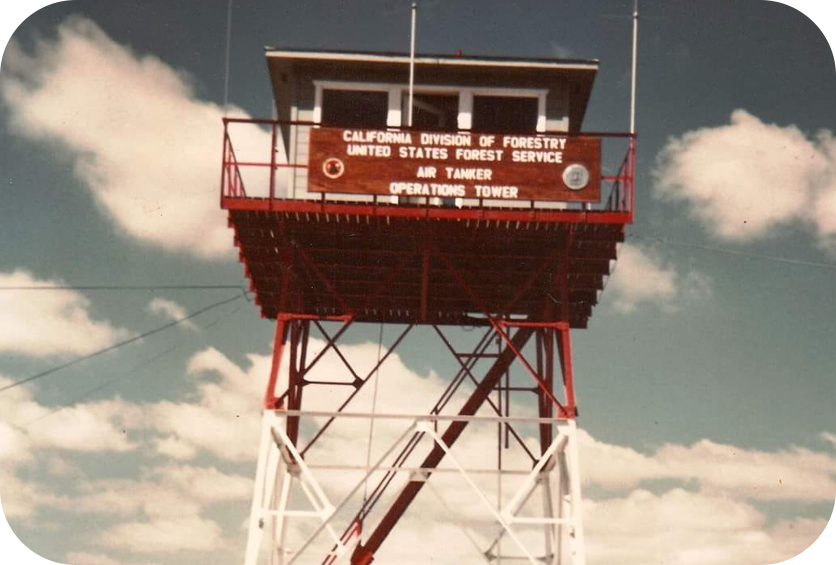
At the beginning of the 20th century, a few loosely organized groups, including at least one logging company, had taken steps to bring about wildland fire protection upon a few scattered properties outside of the Federal Reserves. A major step forward, though, in bringing about a State-level commitment to protect these areas came in 1903. Shortly after assuming office Governor George Pardee communicated to Gifford Pinchot his desire for a joint Federal-State study and survey of the forest situation in California. C. Raymond Clar, in his report Brief History of The California Division of Forestry suggests that Pardee's request energized Pinchot's lobbying efforts for direct control of the federal forest reserve system and no doubt it helped sway President Roosevelt to transfer the Federal Reserves to the Department of Agriculture. The California survey was conducted from 1903 into 1907. Commencement of the project set the stage for the establishment of a new Board of Forestry and the creation of the position of State Forester. On March 18, 1905 the State Legislature approved both. The enabling Act, as Clar puts it, became "...the statutory cornerstone for the State forestry agency as it has existed through the ensuing years."
The Board of Forestry appointed E. T. Allen, an Assistant Forester in the Forest Service, as California's first State Forester. Unfortunately, Allen had to leave office the following year (for personal reasons). Not surprisingly, another Forest Service employee, Gerard B. Lull, filled his position. After all, the Federal Agency was practically the only source for qualified foresters. In passing, it might be mentioned that 1906 was also the year that the State Legislature returned the Yosemite Grant and Mariposa Grove to the Federal Government. While touching upon the subject of parks, the Act of 1905 had placed the State's Big Basin Park in Santa Cruz County under the authority of the Board of Forestry. The State's park system remained under the jurisdiction of the Board until 1927.
The Act of 1905 granted to the State Forester the right to appoint local fire wardens. The State Forester could also "maintain a fire patrol at places and times of fire emergency." The fire patrol system, however, was to be funded by the County in which the action took place. Although the CAL FIRE could be said to have started in 1905 with the creation of the position of State Forester, from 1905 until 1919, the State Forester and the "forestry department" were one-and-the-same. The "department" consisted of the State Forester and a few office staff and assistants based in Sacramento. The remainder of the department was the large body of local fire wardens. They were, however, funded and supported by their local jurisdictions. The State of California was not spending money to maintain a wildland fire protection force.
In 1911 Congress passed the "Weeks Law" which provided fiscal aid for cooperative fire protection work between the Forest Service and qualifying States. In 1919, the California Legislature finally appropriated money for fire prevention and suppression work. The sum of $25,000 was approved and the Forest Service, under the Weeks Law, provided $3,500 for salaries of field men. The State's first four rangers or "Weeks Law Patrolmen" were hired for a four month period covering the summer of 1919. They worked wherever needed but were individually headquartered in Redding, Oroville, Placerville, and Auburn. The State Forester reported that three million acres of watersheds covering the Stanislaus, Mokelumne, Cosumnes, American, Bear, Yuba, and Feather rivers outside of the Federal reserves were to be afforded protection. No explanation has been given as to why the river systems and the "headquarters" locations didn't exactly match. In 1920, the ranger organization was restructured and expanded with ten rangers overseeing ten districts. The districts were: 1) Shasta County; 2) Butte and Yuba Counties; 3) Placer and Nevada Counties; 4) El Dorado and Amador Counties; 5) Tehama County; 6) Colusa County; 7) Lake County; 8) Mendocino County; 9) Napa County; 10) Santa Cruz, Santa Clara, and San Mateo Counties. Over the next decade the district system and the ranger force slowly grew.
In 1917, the State Legislature authorized the establishment of a forest nursery. In 1919 a bill was introduced to purchase land for a nursery site but failed. Meanwhile, the State Highway Commission had become an enthusiastic supporter of a State forestry nursery. They, and many members of the general public, wanted to use the planting stock to beautify public land including roadsides. In 1920 the Commission and the State Board of Forestry agreed to a cooperative venture to establish a nursery. The State Highway Commission had the resources and authority to purchase a tract of land and thus acquired thirty acres in Yolo County near Davis for a nursery site. In 1921 the State Legislature appropriated $20,000.00 to the Board of Forestry for building construction upon this land. This marks the beginning of the building of a physical operating plant for the CAL FIRE.
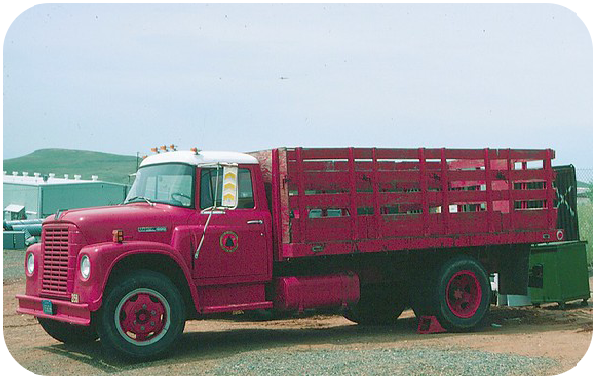
The first State-funded fire lookout building was erected on Mount Bielawski in the Santa Cruz Mountains in 1922. However, in the 1920ís, other than fire lookouts, the construction of buildings to serve the needs of the State Rangers was the individual State Ranger's responsibility. That is to say, the State of California did not fund construction. The "historic" San Jacinto Ranger's Office now located at the San Jacinto Forest Fire Station is the only known surviving State Ranger's office from the 1920s. It was built upon private land through local efforts. In 1923, the State's forestry program supported 16 rangers, 4 inspectors and 2 lookouts. By 1927 the force was up to 28 rangers, 7 inspectors, 6 patrolmen and 9 lookouts. During the interim, Congress had superseded the Weeks Act with the Clarke-McNary Act (of 1924). The law greatly expanded federal assistance to State forestry programs, and California was beginning to avail itself to this funding source.
In 1927, Governor Clement Calhoun Young orchestrated a reorganization of State government, creating the Department of Natural Resources with a Division of Forestry and a Division of Beaches and Parks. Administration of the State's parks was henceforth no longer a responsibility of the State Board of Forestry. The California Division of Forestry, as the forestry agency was now officially designated, would be headed by the State Forester who reported administratively to the Director of the Department of Natural Resources. From 1927 until the formation of the CCC, the CAL FIRE fire lookouts nearly tripled in size, with much of this activity performed in cooperation with the Forest Service. The first State fire trucks were not acquired until 1929. It's unknown where they were housed but they are believed to have been sheltered in buildings provided by the counties they were assigned. The first official State "standby crews" (seasonal fire fighters) were not hired until 1931.
The old fire station buildings on Mount Zion are the only pre-CCC era suppression station facilities remaining in the CAL FIRE property inventory. They were constructed as part of the State labor camp located at the site in the winter of 1931-32. The buildings were "reconstructed" in the early 1950s.
By 1931 a number of counties had entered cooperative agreements with the State Forester in order to have the State place a Ranger in their territory. However, the State Ranger continued to look to his sponsoring County's Board of Supervisors for any material aids and staff such as clerks, truck drivers and even Assistant Rangers that he needed. Almost nothing was available from the State budget for physical improvements to lookouts, telephone lines, firebreaks, or offices. It was in 1931 that the Board of Forestry hired Burnett Sanford, a forest engineer, to study what Clar reports had become a "complex and generally unplanned system of allotting operating funds among the numerous geographical sub-divisions into which the Division of Forestry had been allowed to grow." The "Sanford Plan" basically proposed that State funds be apportioned along the lines of "weighted values" of area protected. The values were couched in the general concepts that had brought about the National Forests. Specifically, the State was concerned about watershed management and timber management in the larger sense and also for protection of public recreation and wildlife habitat areas. Sanford criticized the type of rural organization that had occurred, for one reason because the higher valued mountain regions were receiving less fire protection than the low lying range lands and valley floors. Under the Sanford Plan, the State was divided into three classes. Class 1 lands had the highest value to the State embracing watershed, timber, and recreation areas. Here, the State would focus its fire protection efforts. Class 2 lands had no general value but would be protected as needed because fires could potentially threaten Class 1 lands. Class 3 lands were left to the local citizenry to protect.
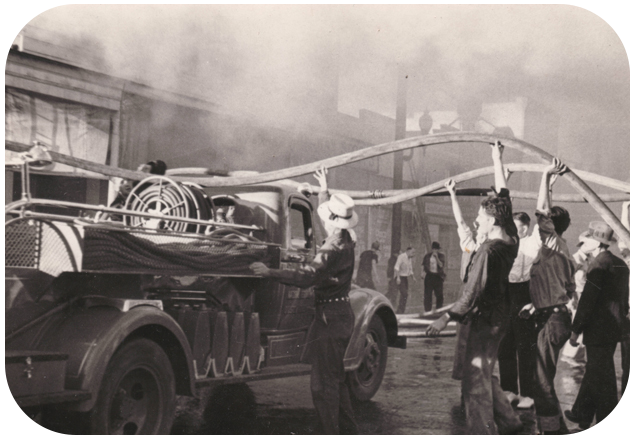
President Roosevelt asked Congress to set up a Federal Relief Administration to oversee a grants program designed to relieve the Nation's unemployment crisis. Unemployment relief through the performance of useful public works was the President's philosophy. In April of 1933 the Emergency Conservation Work (ECW) program was established. It became known almost instantly as the Civilian Conservation Corps (CCC). In California, the Forest Service's District Forester, Stuart Show, had developed a plan of attack on how to utilize this new labor pool. Funded by ECW money, the CCC would be assigned three basic tasks: firebreak construction, lookout station building, and general improvements. The "Three Cs" would cut fuel breaks around the State, with particular emphasis on establishing the "Ponderosa Way Firebreak." This continuous fuel break extended the length of the Sierra Nevada Mountains, and into the Cascades, ending north of Redding. The firebreak was intended to be a permanent defensive line between the lower foothill regions and the higher elevation National Forest lands. The second project, construction of an integrated, statewide fire detection network would bring to fruition the recommendations of an investigative group that Show had organized in 1930 at the California Forest and Range Experiment Station (Pacific Southwest today) to scrutinize every aspect of the fire detection problem in California. The group had recommended an integrated, network of fire lookouts be setup to cover all of the State's fire prone areas from the Oregon line to the Mexican border. The third task, general improvements, included the building of administrative and fire suppression bases, installation of roads, bridges, telephone lines and innumerable other conservation projects.
The ECW programs lasted from 1933 to 1942. All told, the CCC-WPA laborers constructed over 300 lookout towers and houses, some 9,000 miles of telephone lines, 1,161,921 miles of roads and trails and erected numerous fire stations and administrative buildings in California. The CCC had also planted over 30 million trees and had spent nearly one million "man days" in fire prevention and suppression activity. Because the CCC was expected to fight forest fires, they constituted the single largest wildland suppression force ever assembled in American history.
The Forest Service system of lookouts, guard stations, and ranger stations had been renovated, replaced, and/or expanded. For the California Division of Forestry, a system of fire stations and lookouts now existed throughout many of the fire prone areas of California. The Forest Service had identified about 60 sites for the CAL FIRE detection system. Approximately 50 new lookouts were erected by the Civilian Conservation Corps for the California Division of Forestry. At least 30 of these stations were on sites previously not utilized by the State agency. Most of these lookouts were erected from 1934 to 1936. Some of the fire suppression camps located at the CCC camps became permanent State fire stations. In other instances a "spike camp" was extended from a base CCC camp. This spike camp would eventually evolve into a permanent fire suppression camp in the CAL FIRE system. Clar reports that State Forester Pratt remarked that the CCC program thrust the CAL FIRE "twenty years ahead of itself." As Clar comments "That was a modest boast if otherwise anticipated progress was to be measured by prior achievement."
As the CCC capital improvement plan unfolded, the CAL FIRE instructed a few of its Sacramento staffers to, as Clar reported, "study and prepare plans for an orderly development of fire lookouts, crew stations, telephone lines and the personnel and auxiliary equipment to go with them." The group was to take stock of the situation and develop long range goals. In 1938 the Board of Forestry instructed the State Forester to prepare a comprehensive statewide fire prevention, protection, and suppression plan. The outbreak of war in Europe added a new dimension and gravity to the fire planning studies of the 1930s. The war heightened apprehension about the State's vulnerability to fire. The earlier fire planning provided a foundation upon which a revised and solidified plan could be established. In 1939, the Board of Forestry appointed a four-man committee of staff and field men to prepare a fire plan for 1940. Clar was named chairman of the committee. The "Fire Plan of 1940" or "Clar Plan" as it became known redressed the financing scheme laid out in the Sanford Plan. As Clar states, there were "...two simple concepts. First, the idea seemed clearly reasonable that a consistent designation of area need should be indicated by types and numbers of units in the planned protection system, as modified by climate, geography, and the local fire problem... The second concept required a strict segregation of State responsibility from that of any other entity, government or private, and the use of State money to meet that responsibility."
The main significance of the Clar Plan was the proposition that the "State of California was to assume complete jurisdiction and responsibility for suppressing forest and watershed fires" on lands so designated by the State and that all other areas were the primary responsibility of the respective city, county or Federal agency in whose jurisdiction it fell. The Clar Plan also proffered that a "physical plan of protection including personnel, structures, communication facilities and equipment [should be] developed strictly upon the basis of need to accomplish the fire control job without the slightest concern for political boundaries or anticipated source of funds." This internal plan of "unification" as Clar put it, was being driven by many factors including the Federal work program and the depletion of "county treasuries" from the continuing economic depression. Although the CCC-WPA programs had given the State of California a physical operating plant for the California Division of Forestry to carry out its wildland fire protection mission the State Legislature had yet to fund the staffing of this new system. The Clar Plan gave a formula for spending but the elected officials in Sacramento needed more motivation before they would commit to the estimated $3,000,000 that the Clar Plan disclosed it would cost to fully implement.
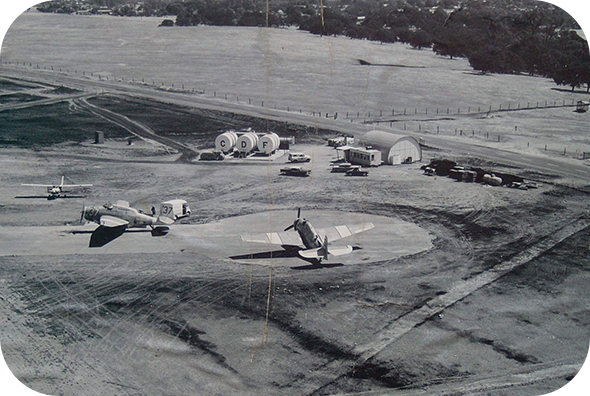
The growing prospect of war had prompted the U. S. Army to instruct all State governments to prepare civil defense plans. In September of 1941, the State of California established the State Council of Defense. The Council of Defense saw in the Clar Plan a mechanism for a statewide fire defense plan. The Council advised the CAL FIRE to be prepared to "assume statewide fire dispatching and standby fire protection on the periphery of cities and vital industries." With Japan's premeditated and vicious attack upon Pearl Harbor, the Aircraft Warning System, which utilized a number of fire lookout facilities to house aircraft spotters, went on war status. Observers were rushed to their respective posts. The U.S. Army had delegated to the Forest Service the responsibility of seeing to it that all lookouts (Federal, State and local) were in readiness. Contingency plans had called for the winterizing of existing lookout stations and the erection of scores of temporary cabins at other strategic locations. Clar, as Chief Deputy State Forester, assumed operation of the CAL FIRE's role in civilian defense and immediately had 30 fire lookouts staffed, all State fire trucks put on standby, and organized a 24 hour dispatch team at the central offices in Sacramento. These civil defense actions quickly added a nearly $40,000.00 deficit to the State budget. In view of the times, State Officials did not object and emergency appropriations during the War years brought about the rapid implementation of the Clar Plan.
Earl Warren was elected California's Governor in 1943. Warren appointed William Moore as Director of the Department of Natural Resources. Moore was familiar with and a supporter of the Clar Plan. Without delay he approved formation of six administrative districts within the CAL FIRE which the Clar Plan had proposed. He also instructed the Chief Deputy State Forester to go, as Clar later wrote, "around the State to inform the boards of supervisors that henceforth the State Division of Forestry would give such fire protection to the delineated State and privately owned timber and watershed lands as a specified number of fire crews and other facilities would provide. And also, whenever necessary the State would pay such emergency fire fighting costs as might be deemed proper by the State. And further, the State would augment its forces to any extent and manner desired by the county when reimbursed for the actual cost of the service provided, plus a five percent administration fee." Within a State structure for basic service, the counties had flexibility to build up their own systems with their own fiscal resources as they saw fit. But the real significance of Moore's action was the committing of the State of California to hire and pay the salaries of seasonal and full-time employees in the operation of a statewide wildland fire protection department. The California State Government was now inextricably in the business of wildland fire control. The California Division of Forestry had come of age.

Shortly after the War, two other milestones in the CAL FIRE's history were reached. The idea of buying cut-over land and establishing a State Forest system reached a State Legislature that was receptive toward forestry. In 1945 a special bill was passed to appropriate $100,000 for the purchase of a tract of land which became designated the Latour Demonstration State Forest in Shasta County. Another appropriation to the tune of $600,000.00 soon followed for the acquisition of land in Tulare County. After the Mountain Home Demonstration State Forest was established in Tulare County the State Legislature codified and enacted rules under which the State Board of Forestry and the California Division of Forestry could acquire, manage, and administer State Forest lands. In 1946 a $2,000,000.00 "purchase fund" was setup by the Legislature. From this the lands which constitute the Jackson Demonstration State Forest were procured. Several other State Forests have been added to the system since then. The State Forest system now includes eight units totaling over 71,000 acres.
The other milestone was the establishment of a prison "honor camp" program. Since formation of the second State Board of Forestry the notion that inmates should be used for conservation projects and wildland fire protection had been promoted by different individuals. During World War II, with a critical labor shortage now in effect, selected prisoners were taken from San Quentin and organized into hazard reduction and emergency fire fighting crews. The success of this operation paved the way for the introduction of a Youth Honor Camp system. In 1945 four such camps were founded and a cooperative arrangement between the California Youth Authority and the California Division of Forestry was approved. The CAL FIRE would provide personnel to supervise field work and provide appropriate fire training. The Youth Authority would maintain custodial care of the wards. The program soon extended to the California Department of Corrections' adult population and a system of honor camps (later renamed conservation camps) was developed.
Today 85 million acres of California is classified as "wildlands." Some 15 million acres are identified as valuable forestland with about half of this being federally owned. In 1945, the Forest Practice Act was passed into law to regulate commercial timber harvesting on the non-Federal lands. The act was revised in 1973 and contains provisions that timber harvest plans for commercial operations are to be prepared by Registered Professional Foresters. CAL FIRE administers the law, and logging operators must be licensed by the CAL FIRE to operate upon non-Federal lands.
